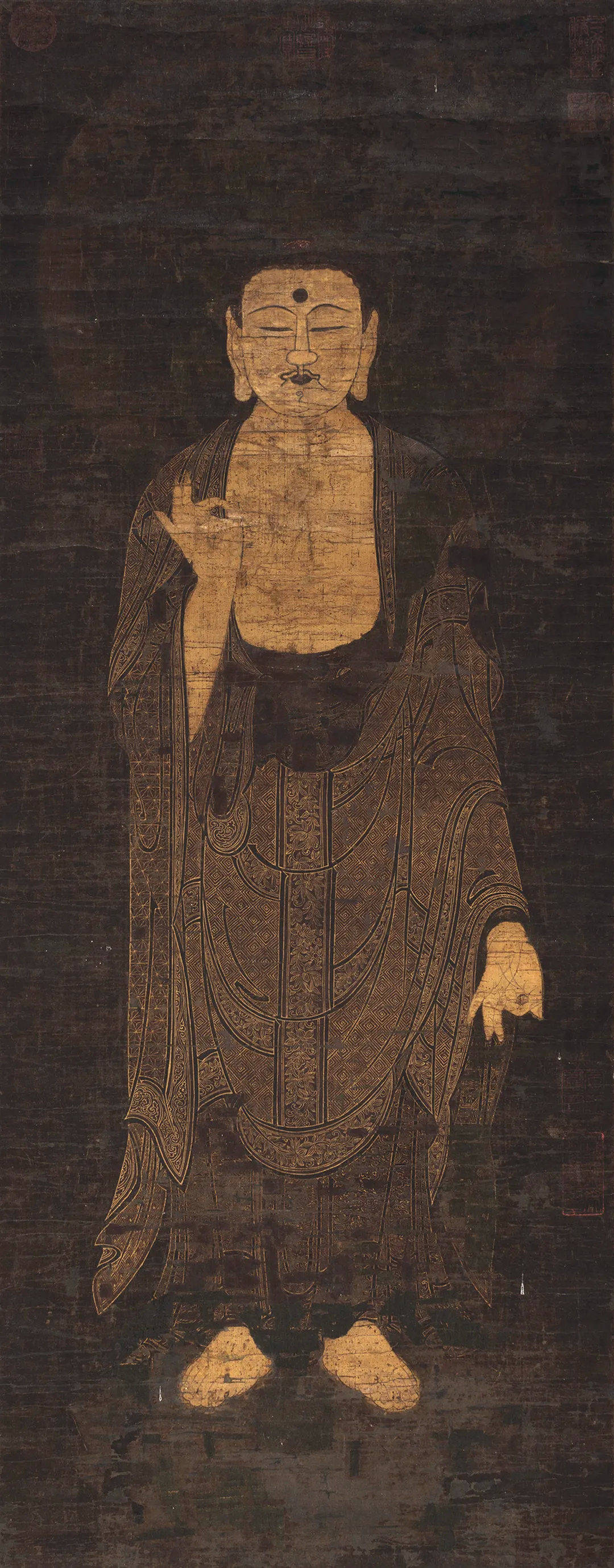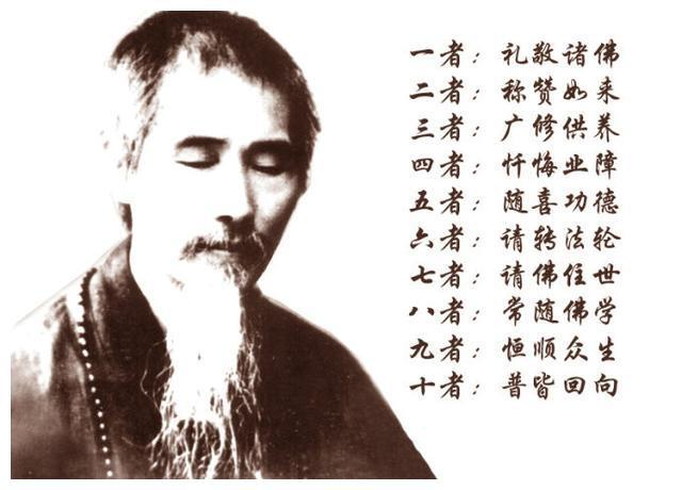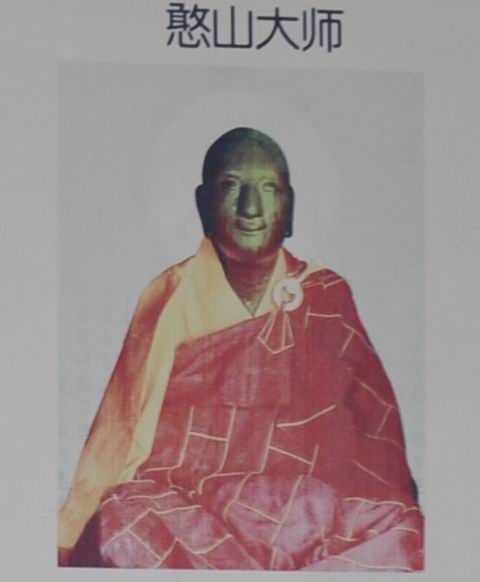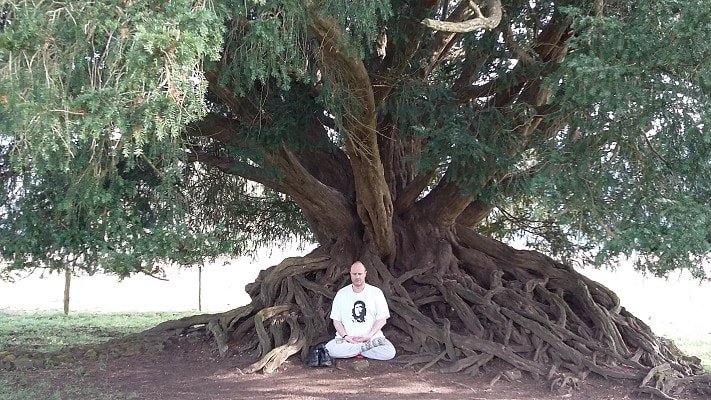|
Chinese Ch'an is the method of permanently altering one's perception. This is achieved by changing 'how' and 'where' the individual places their 'attention'. The default setting for human-beings - which is linked to the evolutionary drive to survive - requires the general attention to be fixed upon the sensing of permanent (external) stimuli - as mediated through the six sense-organs. Modern science, of course, informs us that there are many more than just the assumed 'five' senses in the West (perhaps as many as 'thirty') - but these further senses are in fact specific aspects (or elements) of perception - and easily fall within the Buddha's schematic of defining the 'mind' as a 'sense'. Human ancestors had to be acutely 'aware' of their surroundings if their chances of survival were to be enhanced. After the development of the human mind, body and environment - settled human culture allowed individuals to contemplate their existence. As much of this is speculative in nature - it falls under the subject of religion and spirituality - with the modern trend involving secularised conspiracy theories. The point is that there are many 'external' places (the 'guest' position) where individuals are able to place their awareness. It does not matter what belief system sustains this 'externality' - as the 'guest' position is NEVER left. The Chinese Ch'an tradition offers a methodology to alter, shift and change this orientation. Chinese Ch'an does this by transitioning the default setting of human perception away from the 'guest' position - and toward the 'host' position. The 'host' position is comprised of the empty essence that underlies ALL perception. Therefore, it does not matter where an individual lives, when an individual lived - or the culture that defines the prevailing material conditions - the empty mind ground will ALWAYS underlie whatever physical structures the conditioned elements construct. Today, many spiritual schools are content to pursue a material path that encourages adherents to become attached to this or that outward manifestation - often for a large fee! Being 'attached' to whatever form of externality that takes your attention is not difficult and you certainly do not need another's permission or guidance to attain it. This is why a genuine Ch'an teacher is often unpopular in the world of material externality - as he or she continuously speaks and acts from the 'host' position. The genuine Ch'an teacher is a beacon of stable hope in a sea of changing uncertainty - as was the example of Master Xu Yun (1840-1959). In the meantime, words, silence, actions, and inactions - all serve to turn the adherent's attention BACK (inward) toward the empty essence of ALL material experience. If you are looking for the confirmation of your existing views and opinions (the 'guest') - then you have come to the wrong place. There are many 'businesses' out there that will sell you a robe and an ordination certificate. How's that for unpopularity?
0 Comments
Although eulogised more or less the world over today – Master Xu Yun attracted his fair share of criticism. Although completely indifferent to worldly affairs he was accused of being a ‘rightest’ and a ‘leftist’ at different times in his existence. Those jealous of his spiritual power (and seniority) within the Chinese Buddhist System – accused Master Xu Yun of breaking the very Vinaya Discipline he fervently enforced upon his disciples. Quite often this involved the rules surrounding sexual self-control and celibacy – with Master Xu Yun accused of participating in relations with male acolytes. Of course, there was never any material evidence to substantiate these rumours. At one time a young woman took her clothes-off in front of a meditating Master Xu Yun on a boat packed with witnesses – and he never reacted. It is speculated that this woman was paid to do this in an attempt to secure material evidence regarding Master Xu Yun breaking the Vinaya Discipline.
Part of the reason inspiring these baseless attacks involved the Imperial Japanese presence in China between 1931-1945 – which saw an attempt at manipulating the Chinese Sangha into adopting the Japanese Zen practice of NOT following the Vinaya Discipline and allowing Buddhist ‘monks’ to be married, eat meat and drink alcohol. There were some collaborative elements within a rapidly modernising Chinese culture that viewed Master Xu Yun’s attitude as being old fashioned and behind the times. Master Xu Yun, despite this pressure from without and within Chinese culture, nevertheless, refused to buckle and instead reacted with an ever-greater vigour in calling for the upholding of the Vinaya Discipline! When told what others were negatively saying about him, Master Xu Yun would laugh and brush the insult aside. What others said was viewed by Master Xu Yun as being a product of greed, hatred, and delusion – and the very ignorance that following of the Vinaya Discipline sought to uproot and dissolve into the three-dimensional emptiness of the empty mind-ground. Just as following the Vinaya Discipline represented the pure ‘host’ position – the impure ‘guest’ position represented the dirtiness of the ordinary, mundane world and its machinations. Why follow the latter when the former offered safety, sanctuary, and a relief from human suffering? Pretending to be a ‘monk’ when immersed in the filth of the ‘guest’ position of lay-existence is NOT correctly following the Buddha-Dharma as taught by Master Xu Yun. Master Xu Yun shuffled-off his mortal coil 64-years ago (in 1959) – on October 13th (when the Chinese Lunar Callender is converted into the Western Solar equivalent). He was in his 120th-year and had lived nearly two of the 60-years cycles that define the Chinese Zodiac. Although born in the Year of the Rat – and obviously a survivor – Master Xu Yun had no patience for superstition. Indeed, his biography is strewn with accidents, injuries, and the occasional monastic disciplining (involving corporal punishment). None of this bothered him psychologically (as he was ‘detached’ from his feelings) – even if the experience damaged him physically. The question is - how many Buddhist practitioners today are prepared to be like this? All the Tang and Song Dynasty Ch’an Records pursue exactly the same task of clarifying the ‘host’ and defining the ‘guest’. The realisation of the ‘host’ is preferred – whilst the denying of the ‘guest’ is encouraged. Even so – it is clear that even within Chinese-language sources – the mistaking of one for the other is a continuous hazard. If this is true of Chinese culture – how much more difficult must it be for followers of the Dharma in the West? The Ch’an path may be direct – but this fact does NOT make it ‘easy’. Sometimes it is more convenient for individuals to follow simpler paths – even if these paths are harder – and infinitely less likely to achieve results! Ch’an is NOT like this. As Master Xu Yun aged – his body changed dramatically. This is a reality we all face and are facing – and yet despite these profound shifts in physical existence – it is never viewed within the Ch’an tradition as anything more than changes occurring in the ‘guest’ - as the ‘host’ (which must NEVER be departed from) does NOT change one iota regardless of what happens to the physical body or the environment within which it exists. This definition of reality and priority differs significantly from what mainstream society finds interesting or important. This is the entire purpose of the Buddha-Dharma and why the Ch’an Method exists. Sometimes, Master Xu Yun could NOT stand-up due to his very advanced age. This is why he is photographed sat on a chair. He did unduly NOT care about this situation as the ‘host’ position never varies – whilst the ever-changing ‘guest’ position find its place within the accommodating (and three-dimensional) emptiness. This is the eternal lesson that Master Xu Yun teaches humanity. This is the ‘host-in-host’ (that is the integration of the ‘host’ and the ‘guest’) position which transforms the ‘guest’ so that it is correctly viewed as traversing the surface of the mind - whilst remaining entirely ‘empty’ from start to finish! What about the dishonest, the the lying and the deceptive? What happens when such people 'pretend' to seek Ch'an instruction, guidance or clarification? Generally speaking, this is not a problem. If the Ch'an Teacher, Master or Guide has realised the (enlightened) 'host' position, that is the 'empty mind ground', then the questioner - regardless of their apparent 'honesty' or 'dishonesty' - simply represent the (deluded) 'guest' position, and no further explanation is required. The 'honesty' and/or 'dishonesty' of the enquirer means absolutely nothing as the moral-tone of the words such individuals use are all subject (without exception) to being 'returned' to their essential source. The Hua Tou method does not discriminate or support any form of dualistic thinking or acting. The 'enlightening' function is performed by all genuine Ch'an Masters automatically turn ALL words, regardless of the moral orientation of the enquirer, back to their empty essence. When the enquirer is subjected to this process in an appropriate manner, then all delusive constructs 'drop-away' never to arise again. The genuine Ch'an Master is indifferent and can laugh, smile, remain silent or chastise as the need arises. What matters is the realisation that there is NO action the 'guest' can take which will disrupt the 'host'! When the 'host' rests in the 'host' - the trivialities of the 'guest' have NO place to abide or function! Therefore, those who approach - 'approach' - and when 'struck-down' - they 'leave'. Nothing changes in the reflection and there is NO undue movement in the situation.
The Chinese Ch’an School is said to have been brought to China from India in the 6th century CE by the Indian Buddhist monk – Bodhidharma. The Scripture associated with his transmission was the Lankavatara Sutra. Although associated with the Yogacara School today within popular Buddhism, a debate exists as to its actual place within Buddhist development history, with researchers such as Florin Giripescu Sutton stating that the structure of this Sutra is more evident of a Hinayana-Mahayana crossover, rather than being comprised of a purely ‘idealistic’ arrangement. (See: FG Sutton’s book entitled ‘Existence and Enlightenment in the Lankavatara-sutra'). From my training within the Chinese Ch’an School, I believe FG Sutton’s interpretation is correct. The Chinese Ch’an School is never one-sided in its interpretation of reality, and would not accept a purely ‘material’, or ‘idealistic’ interpretation of reality. However, the Chinese Ch’an School does accept the concept of an ‘integration’ of a (realised) reality that is the perfect synthesis of ‘form’ (matter) and ‘void’ (empty space). Of course, enlightenment involves the ‘turning about’ (Paravritti) of the deepest aspect of the human-mind.
The Standard Sanskrit Dictionary defines the term ‘Paravritti’ (परावृत्ति) in the following ways: barter, rebounding, revolving, change, recoiling, turning back or round, exchange, restoration of property, interchange, returning, not taking effect, reversion of a sentence or judgement and turning about. Within the context of Mahayana Buddhist Sanskrit (as used in the Lankavatara Sutra), the term Paravritti’ (परावृत्ति) means: ‘change’, ‘turning around’, ‘returning’ and ‘turning about’. It implies the permanent ‘turning about’ (as a ‘realised’ achievement of enlightenment) that occurs in the deepest (alaya-vijnana) level of the mind. The ‘deluded’ mind – which is the mind that first embarks upon the path of enlightenment – is ‘inverted’ by nature and definition of the Buddha. To rid the mind of this ‘suffering-inducing’ inversion of mind, an individual must participate in the practice of meditation as a method of effective self-cultivation. Within the Chinese Ch’an School this process involves the use of gong-an contemplation and hua tou investigation. When the inner potential is suitably strengthened, there is a ‘breakthrough’ so that the ridgepole of ignorance is broken, and the inverted-mind is rectified into the non-inverted mind of complete enlightenment. A very good definition of ‘turning about’ (Paravritti) is as follows: ‘Discrimination not rising, there is a turning-back (parāvṛtti), and there is no dependence on anything … When there is a revulsion (parāvṛtti) from discrimination, one is removed from death and destruction; … " (* 8) Gotra (眞性) according to T'ang. (* 9) Parāvṛtti, turning-over, or turning-up, or turning-back’ This ‘turning about’ equates to the third position of the Cao Dong Five Ranks – where the ridge-pole if ignorance is finally broken and a ‘still’ and ‘peaceful’ state of mind is attained. Although only the ‘relative’ (or ‘Hinayana’) position of enlightenment, nevertheless, it is already ‘beyond the worldly’ - because the dualism and discrimination premised upon on it - no longer arises in the mind. There is a ‘revulsion’ toward ALL discrimination - which is the essence (and ‘cause’) of delusion in the mind and suffering in the body and environment. From here, Mahayana enlightenment is achieved through further training (as the Cao Dong of the Five Ranks positions of four and five are traversed). Within the written Chinese language, the Sanskrit term ‘परावृत्ति’ (Paravritti) is represented by the two ideograms ‘反射’ (Fan She). When read together, the concept of a ‘reflection’ (as from a ‘mirror’) is conveyed. Within the Surangama Sutra, the perfectly entitled mind is described as an infinite mirror ‘reflecting’ the entirety of material reality! Through this permanent (and ‘apparent’) reflection, the ‘inverted’ mind is remedied and human perception assumes the ‘correct’ or ‘enlightened’ orientation. (When describing the state of enlightenment to the unenlightened – the analogy of a ‘reflecting mirror’ is invariably used). The ideogram ‘反’ (fan3) carries the meaning of ‘reflect’, ‘repeat’ and ‘return’, etc, whereas the ideogram ‘射’ (she4) means ‘emit’, ‘shoot’ (an arrow) and ‘accurately project’, etc. This means that the Chinese interpretation of the Sanskrit term ‘Paravritti’ means to ‘turn back (i.e. to ‘reflect’) with a perfect accuracy’. These are characteristics of the perfectly enlightened mind within the Chinese Ch’an position. Indian Sanskrit Reference: http://spokensanskrit.org/index.php?mode=3&tran_input=परावृत्ति&script=hk&anz=100&direct=se https://www.wisdomlib.org/definition/paravritti A ‘Personal’, or ‘mind to mind’ transmission is described as follows. Enlightenment is the realisation of the empty mind ground (relative enlightenment) - and the integration of this realisation of with all phenomena (full enlightenment). An enlightened being (or ‘Bodhisattva’) is neither attached to the void or hindered by phenomena – a reality that ‘deepens’ in maturity as the years go by. Transmission is the recognition by an enlightened master that a disciple has realised this state, and is therefore able (and ‘authorised’) to teach others to realise this state. A ‘Supportive’ transmission, by way of contrast, is designed to ‘assist’ and ‘uplift’ a practitioner in preparation for the achievement of ‘relative’ and ‘full’ enlightenment, and to transition into a ‘Personal’ transmission should an individual achieve a suitable status of realisation. Master Han Shan Deqing [憨山德清] (1545-1623) may be taken as a reliable model of a Ch’an monk who realised full self-enlightenment (confirmed through the guidance found in the Surangama Sutra). Master Xu Yun (1840-1959) inherited the Dharma-Name ‘Deqing’ (德清) - or ‘Virtuous Clarity’. Master Han Shan understood that ‘sound’ was only perceptible through a ‘subject’ - ‘object’ duality when the mind ‘moved’. When the mind was ‘stilled’, all perception came to an end for the realisation of ‘relative’ enlightenment’. From this position, and following a period of further training, Han Shan’s mind appeared to ‘expand’ and embrace the entire environment (full enlightenment) - a luminous state within which the mind becomes like a mirror and reflects all things. Another text designed to assist the self-enlightenment process is the Vimalakirti Nirdesa Sutra – within which the enlightened layman – Vimalakirti - ‘corrects’ the Buddha’s monastic disciples who have only realised the state of ‘relative’ enlightenment. Through his ‘supportive’ presence and influence he provides the outer and inner conditions (and expert stimulus) to ‘assist’ these monks to ‘move beyond’ their own limited achievements. Vimialakirti’s example is the ‘essence’ of the Guild of Hui Neng’s ongoing Cao Dong transmission. ACW (5.10.2020)
|
Archives
March 2024
Categories
All
|






 RSS Feed
RSS Feed